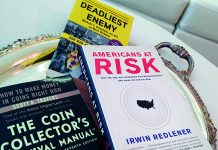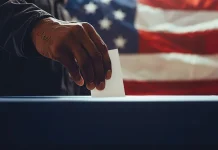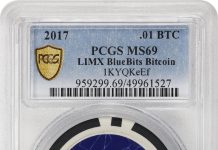
Editor’s Note: Mr. Ralph Ross, Ph.D., is running for the position of president in the American Numismatic Association’s current election. Members of the ANA have until July 1 to cast their ballots. Learn more >>>https://www.coinagemag.com/candidates-set-for-ana-board-of-governors-election
By Ralph Ross, Ph.D.
It’s simple! To give a description of the future of numismatics, I must first tell you a little about myself: I’m a mathematics professor and environmental toxicologist. I have been a coin collector since the age of four years old and will tell you more about my numismatic past and early start in the field.
My introduction to numismatics involved a bubble gum machine and my mother. One day, I was in a small mom and pop-type neighborhood grocery store. The store was owned by the Colemans, a really nice family. We lived precisely diagonally across the street from the store. My older brother, Sam, is six years older than me, and he showed me how to use the vending machines to buy bubble gum and candy. I learned how to get bubble gum from the machine by inserting the proper coins; that is, a penny or a nickel.
On one of my buying sprees at the store, I used the bubble gum machine. It was a regular glass-jar vending machine, with a long neoclassic column and a round two-foot diameter heavy metal base. The glass jar contained colorful, hard-shell gum balls that cost five cents each. I placed my nickel in the gum ball machine and gave the little lever a whirl. I noticed something was wrong, which made it impossible for me to rotate the revolving wheel. I could not get any bubble gum from that machine. Mr. Coleman noticed I was a dissatisfied customer and in his warm voice asked, “Are you having trouble, Ralph?” I said, “Yes, your machine is broken; it won’t turn.” Even though Mr. Coleman was more than six-feet tall, he bent down to look at the gum ball machine. He suddenly said, “Oh, Canada, you have a Canadian nickel,” and “I’ll gladly trade you a United States nickel for your nickel.”
At the age of four, I translated that to mean “give me your money.” I, therefore, said “no” and ran home, breathing hard with shock and emotion, and I asked my mother: “What was wrong with my nickel?” and “Why wouldn’t it work in the gum ball machine?” My mother was a very patient lady, and she told me to calm down and take it easy. She began to explain that I had a nickel from Canada, which was another country. I felt like I had money from around the world; I had no idea what Canada was or where it was located. My mother pointed out that the U.S. nickel was round. There and then, I decided to compare them. As I made my comparison, I noticed the dodecagon 12-sided shape of the Canadian nickel. I became excited at the discovery of something new. My mother suggested that I keep the nickel and save it. I promised her I would.
From that day on, I have collected various things, such as bottle caps, baseball cards, marbles, stamps, spiders, and lottery tickets, and, of course, coins of all kinds. I was rewarded for having the largest bottle cap collection in the Western Michigan community. I have a very deep natural passion for collecting coins.
Today, more than 65 years later, I have continuously involved myself with some form of numismatic behavior. For me, the serendipitous connection to numismatics was natural. During my nearly 40-year tenure as an educator, I introduced numismatics in the classroom to improve academic scholarship and expand interest in the coin collecting hobby. I founded the world’s largest high school coin club: Clements Coin Club (C3). I have also been instrumental in the start of two elementary school coin clubs, five high school coin clubs, and two university coin clubs.
Now, I have a past with numismatics. But what about the future of numismatics?
I don’t think anyone has really looked at the long-term future of numismatics. The focus on numismatics for the next five through 30 years will be based on the projected participation of society. Sometime in the future, we will no longer use the small coinage such as the cent, nickel, and dime. The quarter dollar and dollars are getting more new exposure; these coins seem to be the coins of choice. Citizens using coins and currency in the future will decrease as the trend for payment of goods and service will require electromagnetic waves for a transaction. The U.S. Department of the Treasury actuarial section will march in bold plans for a “cashless” society. The development of “Cyber Space Money” will slow the production of monies as we know it today.
Numismatics will enter in a new mainstream of historical studies. The United States Mint will continue to produce coins and medals routinely for commemorative events or special occasions. The daily use of coinage or monies for miscellaneous payment for goods and services will be obsolete. General society will be connected to a CHIP inserted in the person’s body. Coin collecting will be very different, but the backbone of numismatics has always been and will always be the collector.
The field of numismatics creates four unique disciplines. I call them D-I-C-E.
Dealer: Person selling coins, a business venue with the responsibility to provide for the family. Put beans on the kitchen table.
Investor: Person buying coins, risk taker with disposable income, interested in maturity date, current yield, percentages, ratios, future benefits, and metal composition.
Collector: Bit-by-the-bug, serendipity, a certain affinity for accumulation of finding coins agreeable with your assemblage, the desire could be so great as to take beans off the kitchen table.
Exhibitor: Exhilarating, practice of behaving so as to attract attention to by a public showing of your display, ostentatious, inculcating numismatic scholarship.
The overlapping of the four unique disciplines makes the hobby of numismatics robust and dynamic for entire families. The common denominator of numismatics is the collector. The backbone of numismatics has always been the collector. We must keep the collector and his or her interests strong and sustain them by providing the education, information, forums, and opportunity for discovery and learning that gave great strength to the hobby in the past and will be the cornerstone for its future.
Ralph W. Ross, Ph.D., is a professor of mathematics for the Stafford Municipal School District/Houston Community College System in Stafford, Texas. Dr. Ross completed a Ph.D. in environmental toxicology at Texas Southern University in Houston, Texas. He earned his master’s degree in mathematics from Eastern Michigan University and his bachelor’s degree in mathematics and chemistry from Ferris State University, both in Michigan. Dr. Ross had a teaching fellowship at the University of Michigan, Ann Arbor, and was a visiting undergraduate student in the mathematics department at Massachusetts Institute of Technology (MIT) in Cambridge, Massachusetts. He grew up in Muskegon, Michigan, and moved to Houston, Texas, in 1982. He has been married for 38 years to Phyllis, an attorney and presiding judge, and is the father of three: Jason, Jeremy (deceased), and Jillian, a third-year medical student. Dr. Ross is also a grandfather to three. He has been a coin collector since age four and was instrumental in the start of two elementary school coin clubs, five high school coin clubs, and two university coin clubs.
He is a distinguished and honored numismatist with membership in many numismatic organizations including the American Numismatic Association; Texas Numismatic Association; Florida United Numismatists; Greater Houston Coin Club; Michigan State Numismatic Society; Muskegon Coin Club; Pasadena Coin Club; Bellaire Coin Club; Central States Numismatic Society; National Silver Dollar Roundtable; and the American Numismatic Society. Dr. Ross worked closely with the ANA for the past 43 years. Eight of those years were as a governor, and two of those years were as vice president. He is a past president of the Greater Houston Coin Club, an ANA youth summer seminar counselor, an ANA representative and district delegate, and chair of several ANA committees. Dr. Ross received the ANA Medal of Merit, the Glenn B. Smedley Memorial Award, the Adult Advisor of the Year Award, and two Presidential Awards. He was also named a Numismatic Ambassador.













